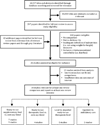Treatment of severe and moderate acute malnutrition in low- and middle-income settings: a systematic review, meta-analysis and Delphi process
- PMID: 24564235
- PMCID: PMC3847503
- DOI: 10.1186/1471-2458-13-S3-S23
Treatment of severe and moderate acute malnutrition in low- and middle-income settings: a systematic review, meta-analysis and Delphi process
Abstract
Background: Globally, moderate acute malnutrition (MAM) and severe acute malnutrition (SAM) affect approximately 52 million children under five. This systematic review evaluates the effectiveness of interventions for SAM including the World Health Organization (WHO) protocol for inpatient management and community-based management with ready-to-use-therapeutic food (RUTF), as well as interventions for MAM in children under five years in low- and middle-income countries.
Methods: We systematically searched the literature and included 14 studies in the meta-analysis. Study quality was assessed using CHERG adaptation of GRADE criteria. A Delphi process was undertaken to complement the systematic review in estimating case fatality and recovery rates that were necessary for modelling in the Lives Saved Tool (LiST).
Results: Case fatality rates for inpatient treatment of SAM using the WHO protocol ranged from 3.4% to 35%. For community-based treatment of SAM, children given RUTF were 51% more likely to achieve nutritional recovery than the standard care group. For the treatment of MAM, children in the RUSF group were significantly more likely to recover and less likely to be non-responders than in the CSB group. In both meta-analyses, weight gain in the intervention group was higher, and although statistically significant, these differences were small. Overall limitations in our analysis include considerable heterogeneity in many outcomes and an inability to evaluate intervention effects separate from commodity effect. The Delphi process indicated that adherence to standardized protocols for the treatment of SAM and MAM should have a marked positive impact on mortality and recovery rates; yet, true consensus was not achieved.
Conclusions: Gaps in our ability to estimate effectiveness of overall treatment approaches for SAM and MAM persist. In addition to further impact studies conducted in a wider range of settings, more high quality program evaluations need to be conducted and the results disseminated.
Figures









References
-
- WHO. Guideline update: Technical aspects of the management of severe acute malnutrition in infants and children. Geneva: World Health Organization; 2013. - PubMed
-
- Bank U-W-TW. Levels and Trends in Child Malnutrition: UNICEF-WHO-The World Bank Joint Child Malnutrition Estimates. Washington D.C; 2012.
-
- WHO. Guidelines for the inpatient treatment of severely malnourished children. South-East Asia Regional Office: World Health Organization; 2003.
-
- WHO. Community-based management of severe acute malnutrition: A Joint Statement by the World Health Organization, the World Food Programme, the United Nations System Standing Committee on Nutrition and the United Nations Children’s Fund. World Health Organization; 2007.
Publication types
MeSH terms
LinkOut - more resources
Full Text Sources
Other Literature Sources
Medical

